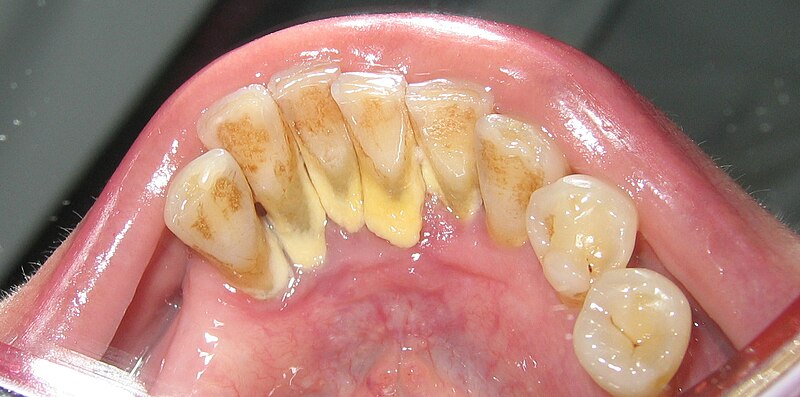Table of Contents
Replacing Your Teeth
Are you dealing with missing or broken teeth? Smiles has a variety of options for you.
What’s the Cheapest Way to Replace My Teeth?

If you’re looking for the most affordable way to replace your teeth, dentures are often the best choice. They’re cost-effective and can restore both function and aesthetics. Partial dentures are available if you’re missing only a few teeth, while full dentures can replace an entire arch.
Learn more: [What Are Dentures?]
What’s the Longest-Lasting Option for Replacing Teeth?
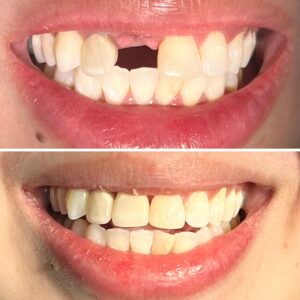
For durability and a natural feel, dental implants are the gold standard. They’re designed to mimic natural teeth, both in appearance and function. While the upfront cost is higher, implants are a long-term investment, lasting decades with proper care.
Learn more: [What Are Dental Implants?]
Are There Options That Don’t Require Surgery?
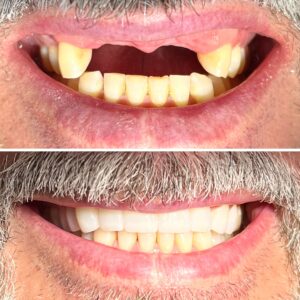
Yes! If you’d like to avoid surgery, a dental bridge might be the right solution for you. Bridges use your natural teeth as anchors to fill the gap left by a missing tooth. They’re stable, effective, and don’t require implant surgery.
Learn more: [What Is a Dental Bridge?]
What Should I Know Before Replacing My Teeth?
-
Bone Health Matters: Smiles dentists recommend the best treatment for your case. If you’re considering implants, maintaining healthy jawbone density is crucial. Bone loss can occur after losing a tooth, so acting sooner is better.
-
Comfort and Fit: Dentures need adjustments over time as your gums change. Implants and bridges, however, provide a more stable fit.
-
Insurance Coverage: While replacement options are usually covered by insurance, you might have to pay out of pocket for part of the cost. We’ll work with your plan to make sure you maximize your benefits and pay as little as possible.
How Do I Decide Which Option is Right for Me?
The right choice depends on factors like cost, the number of teeth you need to replace, and your overall oral health. Here’s a quick comparison to help you decide:
| Option | Cost | Longevity | Invasiveness | Best For |
|---|---|---|---|---|
| Dentures | Low | 5–10 years | Non-invasive | Affordable, non-permanent solution |
| Dental Implants | High | 20+ years | Surgical | Long-term, natural-feeling option |
| Dental Bridges | Moderate | 10–15 years | Minimally invasive | Replacing one or more adjacent teeth |
What Are Dentures?
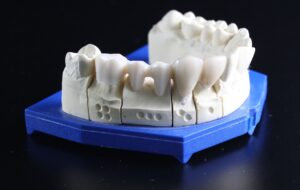
Dentures are prosthetic devices designed to replace missing teeth and surrounding tissues.
They come in two types:
- Full Dentures: Replace all teeth in an arch.
- Partial Dentures: Fill in gaps when some natural teeth remain.
How Do You Create My Dentures?
- Step 1: A dental impression is taken to create a perfect fit.
- Step 2: Your dentures are custom-made in a lab.
- Step 3: After fitting, adjustments are made for comfort.
Cost: Dentures are usually the most budget-friendly option, and are also covered by most insurance plans.
Care: Regular cleaning and soaking keep them in good condition. You may need periodic relining or replacements as your gums and jaw change.
What Are Dental Implants?
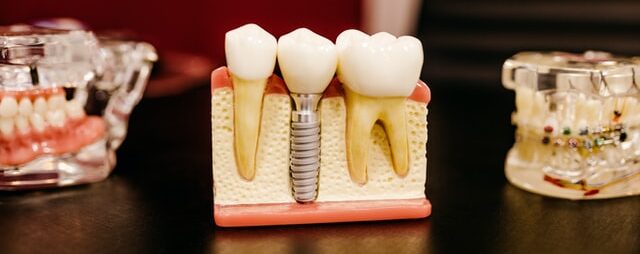
Dental implants are titanium posts surgically placed into the jawbone, serving as roots for replacement teeth. They provide a strong foundation for crowns, bridges, or dentures.
What’s the Process?
Step 1: A consultation and 3D imaging helps us determine your suitability for implants.
Step 2: The implant is placed into the jawbone. A healing period allows the bone to fuse with the implant (osseointegration).
Step 3: A custom crown, bridge, or denture is attached to the implant.
Cost: Implants are a higher upfront investment but save costs long-term due to their durability. Financing options may be available.
Care: Brush and floss as you would natural teeth. Regular dental checkups are essential.
Learn more: [Common Tooth Replacement Questions]
What Are Dental Bridges?
.jpeg)
A dental bridge uses two healthy teeth as anchors (abutments) to support a false tooth (pontic) in between.
What’s the Process?
Step 1: The abutment teeth are prepared by reshaping them to fit crowns.
Step 2: An impression is taken to create the custom bridge.
Step 3: The bridge is fitted and bonded in place, restoring your smile.
Cost: Bridges are mid-range in cost and often covered by insurance.
Care: Similar to natural teeth. Use floss threaders or water flossers to clean under the bridge.
Compare with Implants: [What Are Dental Implants?]
Common Tooth Replacement Questions
1. Is Tooth Replacement Painful?
The level of discomfort depends on the procedure.
- Dentures: Non-invasive and pain-free. Adjusting to wearing them may take a few days.
- Implants: Surgical placement involves mild discomfort during healing, but it’s managed with local anesthesia and pain relievers.
- Bridges: Minimal discomfort during tooth preparation; numbing agents are used for comfort.
2. How Much Does It Cost to Replace a Tooth?
Costs vary depending on the method:
- Dentures: $800–$2,000 per arch.
- Implants: $3,000–$5,000 per tooth (includes implant, abutment, and crown).
- Bridges: $2,000–$3,500 per bridge (depending on materials and number of teeth replaced).
Insurance Tip: Some plans cover the cost for dentures, bridges, or implants. We’re happy to help you navigate your coverage.
Learn More: [What’s the Cheapest Method?]
3. How Long Will My Tooth Replacement Last?
- Dentures: 5–10 years with proper care.
- Implants: 20+ years with excellent oral hygiene and regular checkups.
- Bridges: 10–15 years on average.
The earlier you replace your teeth, the more complications you will prevent, and the longer your replacement will last.
4. Can I Replace My Tooth Immediately After Losing or Extracting It?
It depends on the method:
- Implants: Bone healing usually takes 2–4 months before an implant is placed. Immediate implants may be an option in some cases.
- Bridges/Dentures: These can be fitted as soon as your gums heal after tooth extraction.
We’ll be able to find out the best timing for you during your consultation.
5. Are Dental Implants Worth the Cost?
Yes, for many patients! Implants offer unmatched stability, durability, and a natural look. While they’re a higher upfront investment, they save money over time by reducing the need for replacements and preserving oral health.
Learn more: [What’s the Longest Lasting Option?]
6. What’s the Best Option if I’m on a Budget?
Dentures are often the most affordable choice. However, if you’re considering implants or bridges, we do work with your insurance to maximize your coverage.
7. What Happens If I Don’t Replace a Missing Tooth?
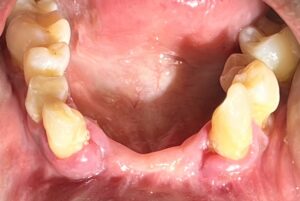
Leaving a gap in your smile can lead to:
- Shifting of nearby teeth, causing misalignment.
- Bone loss in the jaw where the tooth is missing.
- Difficulty chewing or speaking.
Replacing a tooth as soon as possible helps prevent these issues.
8. Can I Get a Tooth Replacement If I Have Other Dental Issues?
We address issues like gum disease or cavities before starting the tooth replacement process. A healthy foundation is key for successful outcomes, so we never skip this step.
Restoring Your Teeth
Can My Broken Teeth Be Restored?
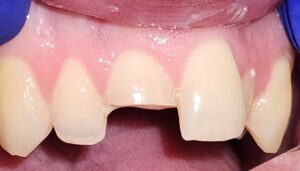
Yes! Our dentists have multiple ways to give you your smile back to how it was. The choice of treatment is up to you, but your Smiles dentist will give you a detailed consultation with their recommendation.
What are Veneers?
Veneers are thin, custom-made shells crafted from porcelain or resin, designed to cover the front surface of your teeth. They improve the appearance of your smile by altering the color, shape, size, or length of your teeth.
Compare with Crowns: [What Are Dental Crowns?]
Veneers are popular with people who want to fix issues like:
- Discoloration that doesn’t respond to whitening.
- Chips or cracks.
- Uneven or misshapen teeth.
- Gaps between teeth.
Think of veneers as a non-invasive way to achieve a dramatically improved smile while maintaining the natural structure of your teeth. Each veneer is tailored to your unique dental needs.
Veneers can make your teeth look completely different! Here’s an example:
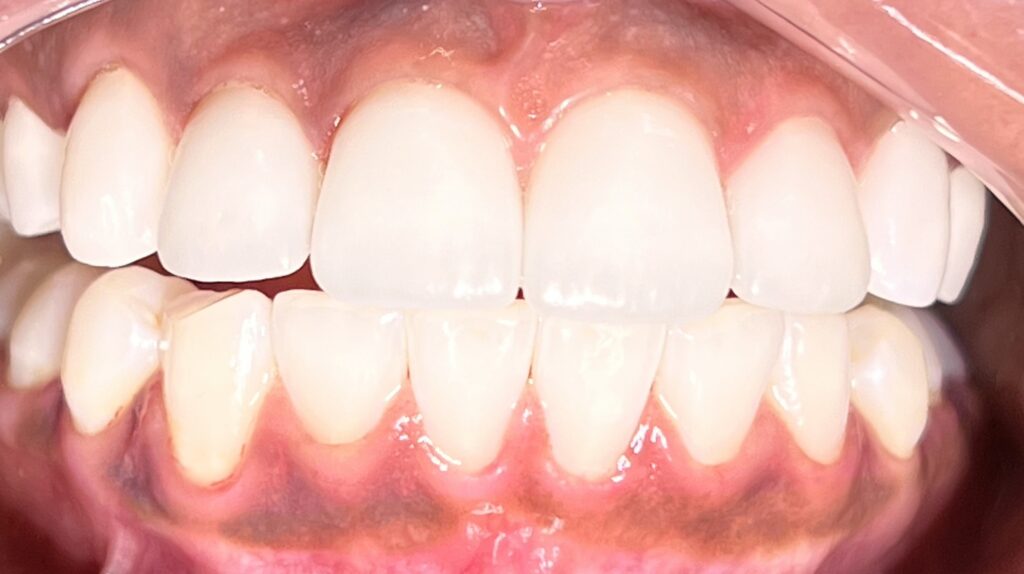
What to Expect During the Procedure
Getting veneers is easy! We simply take an impression of your tooth, and use it to create a porcelain shell. Then we attach it to your teeth!
Preparation: We begin by preparing the tooth surface, which may include reshaping the enamel (top layer of the tooth) slightly to make room for the veneer.
Custom Shade Selection: We work with you to select a shade that complements your natural teeth for a seamless appearance. Our team makes sure your veneers are color-matched for the most natural look.
New veneers are very hard to tell from natural teeth. We don’t only use bright whites: we use the color of your current teeth. All the teeth in the image below are actually veneers!

Custom Veneer Creation: Your veneer is custom-crafted to fit your tooth perfectly, using precise measurements taken during your consultation.
Insertion and Bonding: During your next visit, the veneers are carefully bonded to your teeth with a strong adhesive. We make any final adjustments to ensure a comfortable fit.
Benefits of Veneers
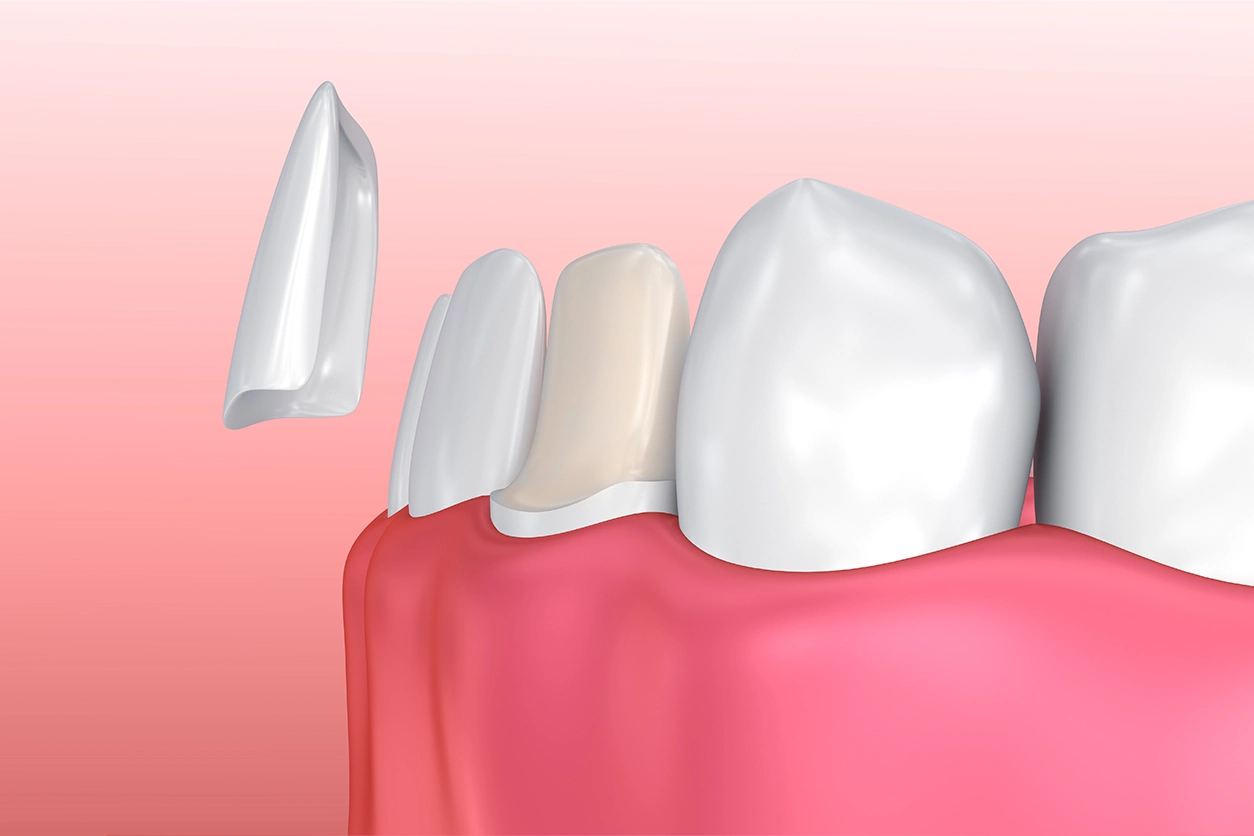
- Stain-resistant materials keep your teeth looking bright longer.
- Customization ensures a natural appearance that matches your unique smile.
- Minimally invasive with little to no discomfort during the procedure.
How to Care for Your Veneers
Veneers are durable and designed to last. Proper care includes regular brushing, flossing, and avoiding habits like biting nails or chewing on hard objects.
It’s important to keep your veneers clean! We recommend professionally cleaning your veneers, and your teeth with a dental hygienist every 6 months to keep them looking as bright as possible.
Veneers can last 10 years or more with proper care!
Common Concerns and Questions
Will I need to replace my veneers? Veneers can last many years with good care. However, they may need replacement eventually due to normal wear and tear.
Can I get veneers if I have gum disease? Healthy gums are essential, so we’ll treat any gum issues before starting.
Do veneers feel heavy? No, veneers are super thin and designed to feel natural in your mouth.
Can I still get cavities under veneers? Yes, maintaining good oral hygiene is critical to prevent decay of the underlying tooth.
How do veneers compare to crowns? Veneers cover only the front of the tooth and are mostly used for cosmetic purposes, while crowns encase the entire tooth and provide structural reinforcement.
What are Dental Crowns?
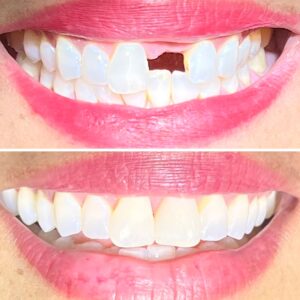
Crowns are custom-made caps that cover damaged, decayed, or weakened teeth. They restore both the function and appearance of your tooth, protecting it from further damage and helping you chew, speak, and smile with confidence.
We find that patients with the following issues like crowns the most:
- Severe tooth decay that can’t be treated with fillings.
- Cracks or fractures in teeth.
- Worn-down teeth due to grinding or aging.
- Teeth that have undergone root canal therapy.
The Crown Procedure
Preparation: The tooth is prepared by removing any decayed or damaged areas and shaping it for a perfect crown fit.
Composite Core (if needed): Sometimes, if the tooth structure is severely weakened or decayed, a composite core is used to build up the tooth. This acts as a foundation, providing additional support for the crown. The composite material is biocompatible and strengthens the remaining tooth structure, allowing for a secure bond with the crown.
Crown Creation: Your crown is custom-made in a lab to match the color, shape, and size of your natural teeth, ensuring a natural look.
Fitting and Bonding: Once your crown is ready, it is carefully fitted and bonded to your tooth, ensuring a secure and comfortable fit.
Benefits of Crowns
- Strengthens weakened teeth and protects them from further damage.
- Restores the appearance of your smile with natural-looking materials.
- Improves chewing ability and overall oral function.
How to Care for Your Crown
To ensure the longevity of your crown, maintain regular brushing and flossing, and avoid using the crowned tooth to chew extremely hard foods, which could damage it.
Here’s some more advice from Smiles dentists:
- Brush and floss around your crown daily to keep the surrounding gum tissue healthy.
- Use a nightguard if you grind your teeth to protect your crown from unnecessary wear.
- Visit your dentist regularly to ensure the crown remains in good condition.
Common Concerns and Questions
How long do crowns last? Crowns are VERY durable and can last between 10–15 years with proper care.
Will my crown look natural? Yes, crowns are color-matched to blend with your surrounding teeth, giving a natural appearance.
What if I feel discomfort after the crown is placed? Some sensitivity is normal initially, but if discomfort persists, our team is here to help with any adjustments.
What materials are used for crowns? Crowns can be made from porcelain, ceramic, metal, or a combination. In our experience, porcelain and ceramic are most popular, due to their natural appearance.
Will my crowned tooth be sensitive? Some sensitivity is normal right after the procedure but should subside within a few days.
Can I replace an old crown? Yes, we can remove and replace worn or damaged crowns.
What Are Fillings?
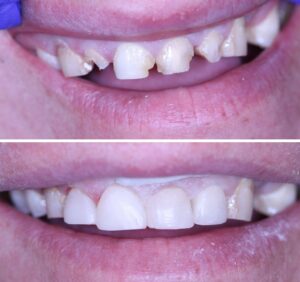
Fillings are a common treatment for cavities and minor tooth damage. They restore the structure and function of your tooth by filling in areas where decay or wear has compromised the enamel. Fillings can also repair small chips or cracks, preventing further damage and preserving the tooth.
Fillings come in several materials, including:
- Composite Resin: Tooth-colored, durable, and highly aesthetic. These look super realistic!
- Amalgam: A silver-colored material known for its strength and affordability.
- Gold: A premium material, extremely durable but not very common today. We rarely use gold at Smiles.
- Ceramic: Tooth-colored and resistant to staining, ideal for larger cavities.
What to Expect During the Procedure
Getting a filling is a straightforward process:
- Numbing the Tooth: Local anesthesia ensures you’re comfortable throughout the procedure.
- Removing Decay: The decayed portion of the tooth is carefully removed, leaving only healthy tooth structure.
- Cleaning and Prepping: The cavity is cleaned and shaped to ensure the filling bonds securely.
- Placing the Filling: The chosen material is placed in layers, hardened with a special curing light, and shaped to fit your bite.
- Polishing: The filling is polished to a smooth, natural finish for comfort and appearance.
When Are Fillings Needed?
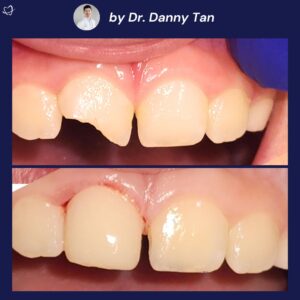
Fillings aren’t just for cavities. They’re also used to:
- Repair small chips and cracks in teeth. (see above)
- Restore worn-down teeth from grinding (bruxism).
- Replace old or broken fillings.
If you’re experiencing sensitivity, visible damage, or dark spots on a tooth, it might be time for a filling.
Benefits of Fillings
- Restores Function: Allows you to chew comfortably without pain.
- Prevents Further Decay: Seals off the cavity and protects the tooth.
- Quick and Non-Invasive: Typically completed in one visit.
- Aesthetic Options: Composite and ceramic fillings blend seamlessly with your natural teeth.
How Long Do Fillings Last?
The lifespan of a filling depends on the material and your oral hygiene habits:
- Composite Fillings: 5–7 years on average but can last longer with good care.
- Amalgam Fillings: Often last 10–15 years.
- Gold or Ceramic Fillings: Can last 15+ years due to their durability.
Regular checkups ensure your fillings stay in good condition.
How to Care for Fillings
- Brush and floss daily to prevent decay around the filling.
- Use fluoride toothpaste to strengthen enamel.
- Avoid biting into very hard objects to prevent chipping or cracking the filling.
- Schedule regular dental cleanings to maintain overall oral health.
Common Concerns and Questions
Will I feel pain during or after getting a filling?
You won’t feel pain during the procedure due to local anesthesia. Some mild sensitivity is normal afterward and should subside within a few days.
Are fillings noticeable?
Composite and ceramic fillings are tooth-colored and virtually invisible. Amalgam or gold fillings are more noticeable but chosen for their durability.
Can fillings fall out?
It’s rare, but fillings can loosen over time due to wear or trauma. Regular dental checkups help identify and address any issues early.
Can I eat right after getting a filling?
If you received a composite filling, you can eat as soon as the numbness wears off. For amalgam fillings, we recommend waiting a few hours for the material to harden fully.
Are fillings safe?
Yes! Composite and ceramic fillings are biocompatible. Amalgam fillings have been safely used for decades, though some patients prefer other materials for aesthetic reasons.
Tooth Infections
Can I Save My Infected Tooth?
If you’re here, you’re likely dealing with pain or discomfort caused by a tooth infection. Don’t worry—we’re here to help.
Smiles dentists have a few different ways to handle an infected tooth. Let’s dig in.
Tooth Extractions: What You Need to Know

While saving your natural teeth is always our priority, sometimes an extraction is the best way to protect your overall health. An extraction may be recommended if:
- The tooth is severely infected or decayed and cannot be restored.
- You have advanced gum disease that has weakened the tooth.
- A wisdom tooth is impacted (stuck below the gums) or causing crowding.
- A tooth is fractured beyond repair due to injury or decay.
Removing a tooth can relieve pain, prevent the spread of infection, and pave the way for restorative options like implants or bridges.
Learn about the alternative: [What Are Root Canals?]
What to Expect During a Tooth Extraction

Extractions are straightforward procedures, and we ensure your comfort every step of the way.
- Preparation: We start with an X-ray to evaluate the tooth and surrounding bone. Local anesthesia is used to numb the area so you won’t feel pain during the procedure.
- The Extraction: Depending on the tooth’s condition, we either:
- Perform a simple extraction (for teeth above the gums) or
- A surgical extraction (for impacted or broken teeth).
- Aftercare Instructions: Once the tooth is removed, we’ll provide clear aftercare instructions to help you heal quickly and comfortably.
Do Tooth Extractions Hurt?
With modern techniques and anesthesia, extractions are typically pain-free. You may experience some soreness after the procedure, but this is manageable with over-the-counter pain relievers and following our aftercare advice.
How to Care for Your Mouth After an Extraction

Proper aftercare ensures a smooth recovery:
- Bite gently on gauze to control bleeding.
- Avoid rinsing or spitting forcefully for 24 hours to protect the clot forming in the socket.
- Stick to soft foods and avoid drinking through a straw for the first few days.
- Keep the area clean by rinsing with warm saltwater after meals starting the next day.
Healing usually takes about 7–10 days, depending on the complexity of the extraction.
Common Concerns and Questions
How much does an extraction cost?
The cost varies depending on the type of extraction. Simple extractions typically range from $150–$300, while surgical extractions may range from $300–$700 or more. We’ll provide an exact estimate during your consultation.
What if I don’t want my tooth removed?
We only recommend extractions when no other options are viable. If the tooth can be saved with a root canal or another treatment, we’ll always explore that first.
Can I replace my tooth after an extraction?
Absolutely! We offer a range of tooth replacement options, including dental implants, bridges, and partial dentures. Replacing a missing tooth helps maintain your bite, appearance, and oral health.
Is it safe to pull a tooth while it’s infected?
In most cases, extracting an infected tooth is safe and necessary to prevent the infection from spreading. We may prescribe antibiotics before or after the procedure if needed.
Can I go back to work or school after an extraction?
For simple extractions, most patients feel fine returning to normal activities the next day. For surgical extractions, we recommend resting for at least one day.
What are Root Canals?
A root canal is a treatment to remove infection from inside your tooth. The procedure targets the pulp, the innermost part of the tooth, where nerves and blood vessels reside. When the pulp becomes infected or damaged due to decay, injury, or repeated dental procedures, a root canal can save the tooth by removing the infection and sealing the space.
Root canals might sound intimidating, but they’re one of the most effective ways to save a tooth that’s been severely damaged or infected. At Smiles, we make the procedure as comfortable as possible, so you can get back to living pain-free.
Why Would I Need a Root Canal?
Root canals are common treatments, but we only perform them if we really need to. It saves your tooth from extraction, so many patients prefer root canals.
Common signs you may need a root canal include:
- Severe, lingering tooth pain.
- Sensitivity to hot or cold that doesn’t go away.
- Swelling or tenderness in the gums near the tooth.
- Discoloration of the tooth.
- A small bump (abscess) on the gums.
If left untreated, an infection in the pulp can spread, causing more pain, swelling, and potentially leading to tooth loss.
What Happens in a Root Canal Treatment?
Root canals are relatively simple operations: we remove the infected tissue in your tooth and fill the empty space with special material.
Diagnosis and Preparation:
We begin with an X-ray to assess the extent of the infection. Local anesthesia ensures the area is completely numb, so you won’t feel pain during the procedure.
Removing the Infection:
A small opening is made in the tooth to access the pulp chamber. The infected tissue is removed, and the area is cleaned and disinfected.
Filling and Sealing:
The empty canals are filled with a biocompatible material called gutta-percha, and the tooth is sealed to prevent reinfection.
Restoring the Tooth:
Most root canal-treated teeth require a crown to restore their strength and appearance. This step ensures your tooth looks and functions like new.
Do Root Canals Hurt?
In the media, root canals are often shown as terrible operations. Luckily, this is far from the truth.
Contrary to popular belief, root canals aren’t painful!
Modern techniques and anesthesia make the procedure as comfortable as getting a filling. Any discomfort you feel afterward is usually mild and temporary.
How to Care for Your Tooth After a Root Canal
Proper aftercare ensures your tooth heals well and stays healthy:
- Avoid chewing on the treated tooth until it’s fully restored with a crown.
- Brush and floss as normal to keep your mouth clean.
- Take any prescribed antibiotics or pain relievers as directed.
Your tooth might feel slightly sensitive for a few days, but this will subside as the tooth heals.
Common Concerns and Questions
How much does a root canal cost?
The cost depends on the tooth being treated. Root canals for front teeth are less complex and typically cost $500–$1,000, while molars may range from $800–$1,500. We provide a clear estimate during your consultation.
Can a root canal fail?
While root canals have a high success rate, reinfection can occur if the tooth isn’t properly sealed or maintained. Regular dental checkups help catch and address any issues early.
Do I need a crown after a root canal?
In most cases, yes. A crown provides essential protection and restores the tooth’s function, especially for back teeth that endure more chewing pressure.
What happens if I don’t get a root canal?
An untreated infection can spread to surrounding tissues and even lead to more serious health problems. Ultimately, the tooth will likely need to be extracted.
Can a root canal save any tooth?
Not always. If the tooth is too damaged or the infection is too advanced, extraction may be the better option. We’ll evaluate your case and recommend the best course of action.
Learn more: [Can I Save My Infected Tooth?]
Frequently Asked Questions About Tooth Infections
At Smiles, we want to make your experience as comfortable as possible. Here are answers to some of our patients’ most common concerns about tooth infections, extractions, and root canals.
How Do I Know If I Have a Tooth Infection?
Common signs of a tooth infection include:
- Persistent toothache or sharp pain.
- Swelling in your face or gums.
- A foul taste in your mouth or bad breath that doesn’t go away.
- Sensitivity to hot, cold, or pressure.
- A visible abscess or bump on the gums near the affected tooth.
If you’re experiencing these symptoms, contact us immediately. Treating the infection early prevents it from worsening.
What Happens If I Don’t Treat a Tooth Infection?
We don’t recommend this! An untreated tooth infection can lead to serious complications, such as:
- Spread of Infection: The infection can move to other areas, including your jaw, neck, or even your bloodstream.
- Tooth Loss: Without treatment, the tooth will likely need to be extracted.
- Severe Pain: The pain typically worsens as the infection progresses.
Prompt treatment, whether through a root canal or extraction, protects your health and saves your smile.
How Much Does Treating a Tooth Infection Cost?
The cost varies depending on the treatment:
- Root Canal: $500–$1,500 depending on the complexity and tooth location.
- Extraction: $150–$700 depending on whether it’s a simple or surgical extraction.
We’re happy to provide a detailed estimate during your visit and help you navigate your insurance coverage.
Can Antibiotics Alone Cure a Tooth Infection?
Antibiotics can help control the spread of infection, but they don’t address the root cause. The infected tissue must be removed through a root canal or extraction to fully resolve the issue.
How Can I Prevent Tooth Infections in the Future?
Good oral hygiene and regular dental checkups are key to preventing infections:
- Brush twice a day with fluoride toothpaste.
- Floss daily to remove plaque and food particles.
- Schedule professional cleanings every 6 months.
- Avoid sugary snacks and drinks that can lead to cavities.
If you feel sensitivity or notice a cavity forming, don’t wait—early treatment can stop infections before they start.
Will My Toothache Go Away on Its Own?
A toothache caused by an infection won’t resolve without treatment. The pain may subside temporarily as the nerve dies, but this doesn’t mean the infection is gone. Seek professional care to avoid further complications.
Is It Normal to Feel Nervous About a Root Canal or Extraction?
Absolutely! Many patients feel anxious, but modern techniques ensure these procedures are as comfortable and pain-free as possible. Our team will walk you through every step, answer your questions, and ensure you feel at ease.
How Long Does Recovery Take After Treatment?
- Root Canal: Most patients feel back to normal within a day or two, especially if the tooth is restored with a crown.
- Extraction: Simple extractions typically heal within 7–10 days. Surgical extractions may take a bit longer, but following aftercare instructions will help speed up recovery.
Dental Hygiene
Why is Professional Teeth Cleaning Important?
Maintaining good oral hygiene is essential for keeping your teeth and gums healthy. This section answers your questions about dental cleanings, what happens if oral care is neglected, and how to build a strong daily hygiene routine.
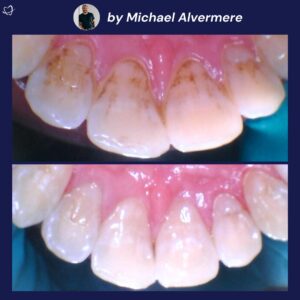
Good dental hygiene helps prevent:
- Cavities: Plaque buildup can lead to tooth decay.
- Gum Disease: Poor hygiene causes gum inflammation, bleeding, and eventually periodontitis.
- Bad Breath: Regular cleaning removes odor-causing bacteria.
- Tooth Loss: Gum disease and decay are the leading causes of tooth loss.
Healthy teeth and gums also contribute to your overall well-being, reducing the risk of systemic conditions like heart disease and diabetes.
Neglecting to clean might lead to tooth infection: [Can I Save My Infected Tooth?]
What Happens During a Cleaning?
A professional cleaning goes beyond what brushing and flossing can do at home. Here’s what to expect:
- Plaque and Tartar Removal: A hygienist uses specialized tools to remove hardened tartar and plaque from your teeth and gum line.
- Polishing: After tartar removal, your teeth are polished to remove surface stains and leave them feeling smooth.
- Fluoride Treatment (if needed): A fluoride gel or varnish is applied to strengthen enamel and protect against cavities.
How Often Should I Get a Cleaning?
We recommend scheduling professional cleanings every 6 months. However, if you’re prone to gum disease or cavities, more frequent cleanings might be necessary.
How Do I Keep My Teeth Clean at Home?

Here’s how to keep your teeth and gums healthy at home:
- Brush Twice a Day: Use fluoride toothpaste and a soft-bristled toothbrush. Brush for at least two minutes, focusing on all surfaces of your teeth.
- Floss Daily: Clean between your teeth to remove plaque and food debris that your toothbrush can’t reach.
- Use Mouthwash: Rinse with an antibacterial mouthwash to kill bacteria and freshen your breath.
- Eat a Balanced Diet: Limit sugary snacks and drinks, and include calcium-rich foods to strengthen teeth.
- Visit the Dentist Regularly: Routine checkups and cleanings catch problems early and keep your mouth in top condition.
What Happens If I Don’t Keep Up With My Oral Hygiene?
Neglecting dental hygiene can lead to a range of issues, including:
- Plaque and Tartar Buildup: Plaque hardens into tartar, which can only be removed during a professional cleaning.
- Gingivitis: The first stage of gum disease causes red, swollen, and bleeding gums.
- Periodontitis: Advanced gum disease that damages the bone supporting your teeth, leading to tooth loss.
- Cavities: Decay penetrates deeper into your teeth, eventually requiring fillings, root canals, or extractions.
Common Concerns and Questions
How Long Does a Cleaning Take?
A typical cleaning appointment lasts 30–60 minutes, depending on the amount of plaque and tartar buildup.
Does a Cleaning Hurt?
Most patients find cleanings comfortable. If your gums are sensitive, let us know—we can adjust the process or use a numbing gel.
Can I Skip Flossing?
No! Flossing is essential for removing plaque and food particles from between your teeth. Skipping flossing allows bacteria to thrive in these hard-to-reach areas.
What Toothpaste Should I Use?
It’s easy to overthink toothpaste. All you really need is one with flouride. If you have specific needs, such as sensitivity or whitening, we can recommend the best product for you.
How Do I Know If I Have Gum Disease?
Early signs include:
- Red, swollen, or bleeding gums.
- Persistent bad breath.
- Receding gums or loose teeth.
If you notice these symptoms, schedule a visit immediately.


